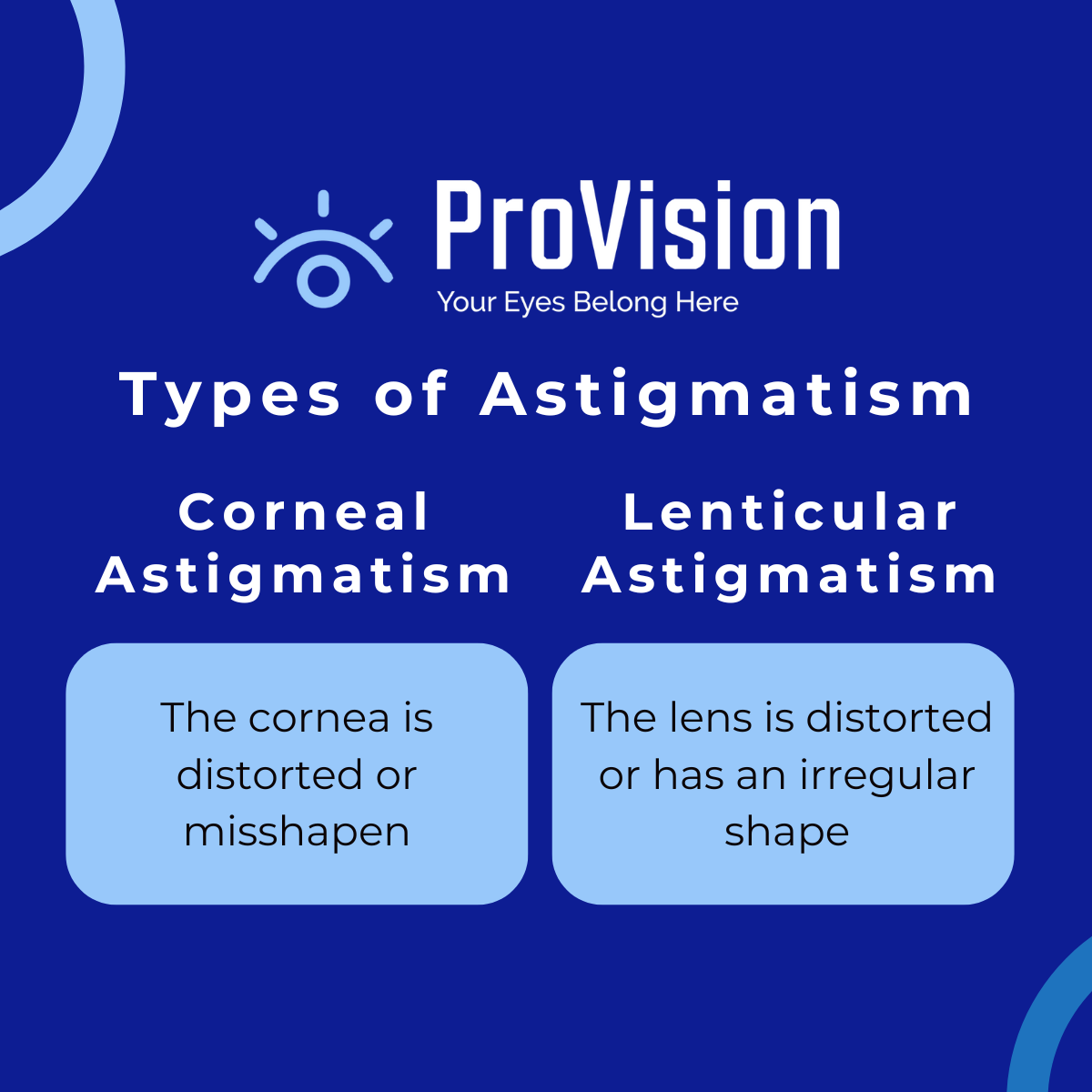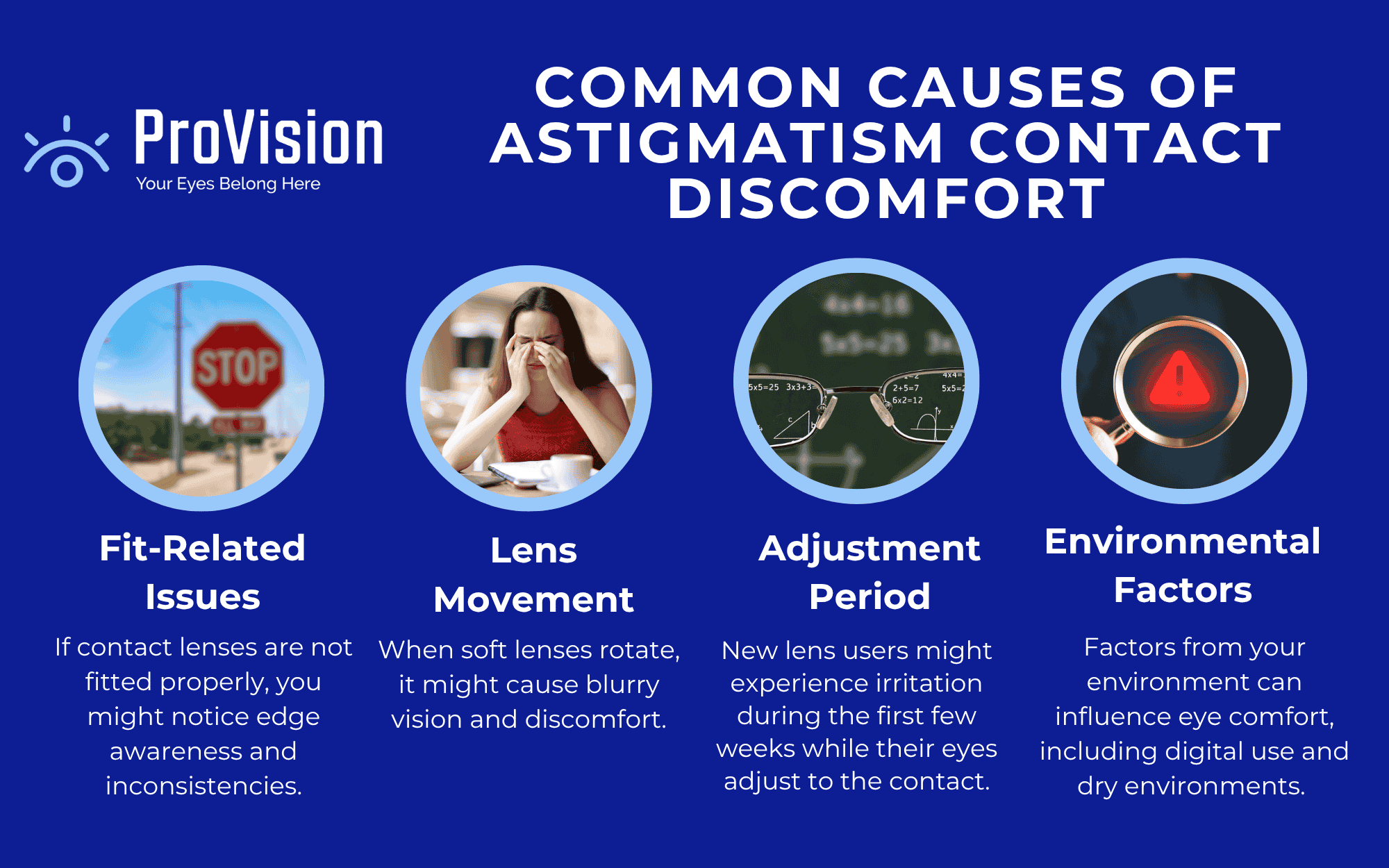Why Are Astigmatism Contacts Uncomfortable?
At a Glance: Astigmatism contacts can feel uncomfortable because they're specially designed to correct an irregular cornea shape, requiring a unique fit and rotation. The lens thickness and movement needed for proper vision correction can cause initial discomfort. However, proper fitting, following adaptation periods, and using modern lens materials can significantly improve comfort.
For millions of people with astigmatism, contact lenses offer freedom from glasses but sometimes come with comfort challenges. These specialized contacts are designed differently from regular contacts to address the unique shape of an astigmatic eye. While they effectively correct vision, the initial adjustment period can feel uncomfortable as your eyes adapt to their distinct design and movement patterns. After this period, discomfort can persist for a variety of reasons, which can include fit issues, environmental factors, and other factors that can vary by patient.
Understanding why astigmatism contacts might feel uncomfortable helps you understand what you can expect during the adjustment period and practical solutions to improve your wearing experience. Make informed decisions about your eye care to find the option that best fits your needs.
Understanding Astigmatism and Contact Lens Design
Astigmatism occurs when your cornea or lens has an irregular curve, causing light to focus on multiple points rather than a single point on your retina. This common vision condition results in blurred or distorted vision at any distance. People with astigmatism often experience symptoms including:
Eye strain
Headaches
Distorted or blurry vision
Difficulty seeing clearly, especially at night and in low light conditions.
The impact that astigmatism has on vision varies depending on the severity of the irregular curve, which is impacted by the astigmatism type. The two primary types of astigmatism are:
Corneal Astigmatism: Occurs with a distorted or misshapen cornea
Lenticular Astigmatism: Occurs with a distorted lens
The irregular shape of an astigmatic eye prevents light from focusing properly on the retina, leading to vision problems that require correction.
Two main types of contact lenses are designed specifically for astigmatism correction.
Toric Lenses
These soft contacts have different powers in different meridians of the lens, specifically engineered to correct astigmatism. They are weighted at the bottom to prevent rotation and maintain proper orientation. The thickness of these lenses varies across different zones to create the required optical power corrections, which can contribute to awareness of the lens.
Rigid Gas Permeable Lenses
Also known as RGP or GP lenses, these maintain their shape on the eye, helping to mask corneal irregularities and provide clear vision. RGP lenses require even more exact fitting than soft toric lenses because they're less flexible.
These specialized contacts feature unique design elements to address astigmatism effectively. Stabilization methods, such as truncation (a slightly flattened bottom edge) or thin zones at the top and bottom of the lens, help keep the lens properly aligned. Small markings or rotation markers on the lens surface help eye care professionals verify proper orientation during fitting.
The sophisticated design of these lenses makes proper fitting more complex than standard contact lenses, requiring precise measurements and possibly several adjustments to achieve optimal vision correction and comfort.
Common Causes of Discomfort
Astigmatism contact lenses can cause discomfort for several reasons. Understanding these common issues helps explain why some wearers experience challenges with their lenses.
Lens Rotation and Movement
Toric contact lenses have a special design that must maintain a specific position on your eye to correct astigmatism. When these soft lenses rotate, which typically happens during blinking or rapid eye movements, they can cause blurred vision and physical discomfort. The weighted bottom of toric lenses should prevent excessive movement, but factors like eye shape and tear film can affect how well the lens stays in place.
RGP lenses are firmer and smaller, which can lead to initial awareness of the lens edges. Both types need proper positioning to work correctly, but they achieve this differently – toric lenses use gravity, while RGP lenses rely on their rigid structure.
Adaptation Period
The adjustment time varies by lens type. New toric lens users typically need 1-2 weeks to adapt, with mild irritation or occasional blurry vision being common. RGP lens wearers often require 2-4 weeks and might notice more initial discomfort due to the firm material.
During adaptation, you may experience:
Increased tear production
Foreign body sensation
Slight irritation during blinking
These symptoms usually decrease as your eyes become used to the lenses.
Chronic Eye Conditions
Eye conditions are a common cause of eye discomfort. Getting started with new contacts can affect existing eye symptoms or, in some cases, cause additional symptoms.
Meibomian Gland Dysfunction (MGD)
MGD occurs when the meibomian glands either do not produce enough oil or produce oil of poor quality, causing faster tear evaporation. This can cause symptoms that make it harder to adjust to contacts, including dry eyes, blurred vision, and foreign body sensations. Patients with MGD may need frequent lens replacement or additional eye care.
Ocular Rosacea
This condition causes inflammation and pain in the eye and the skin surrounding the eyelid. While the exact cause is unknown, ocular rosacea might occur due to genetic predisposition and environmental causes. Increased inflammation from ocular rosacea can make contact lens wear uncomfortable and patients may require additional treatment.
Fit-Related Issues
The exact measurements of your eye determine which lens size and shape will fit you best. RGP lenses require even more exact fitting than soft toric lenses because they're less flexible. An improper fit can cause the lens to sit incorrectly on your eye.
When the curve of the lens doesn't precisely match your eye's surface, you might notice:
Edge awareness
Lens movement during blinks
Inconsistent vision correction
Environmental Factors
Your surroundings play a big role in contact lens comfort. Common environmental influences include:
Extended Computer Use: This can reduce how often you blink, leading to dry eyes and increased lens awareness.
Dry Environments: These pull moisture from your eyes and make your contacts feel less comfortable.
Air Conditioning & Heating: Air conditioning lowers humidity, which can lead to increased tear evaporation, and heating systems dry out indoor air, which can exacerbate dry eyes
RGP lenses might be more affected by debris getting under the lens, while toric lenses are more likely to dehydrate in dry conditions. Using artificial tears and other lubricants specifically approved for contact lenses can help maintain moisture and prioritize sharper vision throughout the day.
Solutions and Comfort Improvements
Getting the right fit for astigmatism contacts starts with professional measurements at your eye doctor's office. Your optometrist will use specialized equipment to map your cornea's unique shape and determine the exact specifications needed for your lenses. These precise measurements help prevent lens rotation and discomfort.
A proper trial period matters when starting with new astigmatism contacts. Your eye care provider will have you test different lens brands and materials to find the most comfortable option. During this time, they can make adjustments to the fit and prescription to optimize your vision and comfort.
Following a gradual breaking-in schedule helps your eyes adjust to toric lenses. Start by wearing them for 4-6 hours on the first day, then increase wear time by 2 hours each day until you reach your target duration. This gentle approach allows your eyes to adapt while minimizing irritation.
Modern toric lenses use advanced materials that retain moisture throughout the day. Silicone hydrogel options allow more oxygen to reach your cornea while staying hydrated longer. Some brands feature special surface treatments that resist protein deposits and maintain a smooth, wettable surface.
Alternative Lens Options
If standard lenses for astigmatism aren't providing enough comfort, you might need to consider another option. Discuss these alternatives with your optometrist:
Daily Disposable Lenses: These eliminate the buildup of deposits.
Hybrid Lenses: These specialized lenses combine rigid and soft materials for stability.
Scleral Lenses: Typically used for dry eyes, these vault over the cornea to avoid direct contact.
Cleaning & Care for Astigmatism Contacts
Follow these tips for better success with astigmatism contacts:
Clean lenses thoroughly using the recommended solution
Replace lenses on schedule to avoid deterioration
Take periodic breaks during long days of computer use
Have regular check-ups to monitor the contact fit and eye health
Treat underlying dry eye disease or any other conditions that might impact eye health
Schedule a Consultation with ProVision to Find Your Eye Care Solution
While wearing contacts can feel uncomfortable initially, proper fitting and care make a significant difference. If you're interested in specialized contacts, it's important to visit an experienced eye care professional. At ProVision Eye Associates, our detail-oriented optometrists specialize in precise contact lens fittings. We measure your eye's unique shape to recommend the most comfortable lens options.
Don't settle for uncomfortable vision correction – schedule an appointment with ProVision today. Our team will help you find the perfect eye care solution while prioritizing both vision clarity and comfort.




